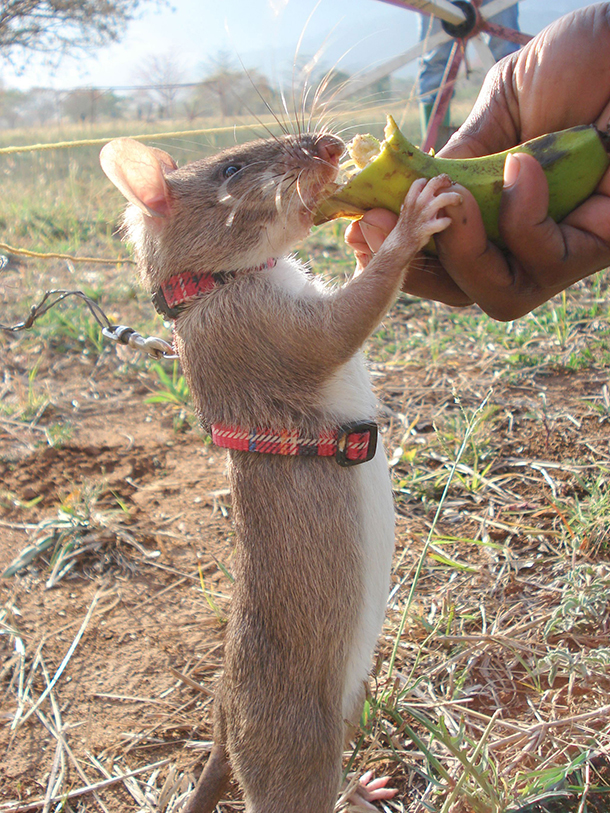Science Note: Rats Against Poachers
Air Date: Week of November 11, 2016

A landmine-detecting rat enjoys the spoils of labor (Photo: Gooutside, Wikimedia Commons CC BY 2.0)
African pouched rats can grow to a yard long, and have a very acute sense of smell. So the US Fish and Wildlife Service is devoting research funds to study whether they can sniff out trafficked animal products and timber.
Transcript
[SCIENCE NOTE THEME]
CONNELLY: The African pouched rat isn’t quite like the rodents you see scurrying along subway tracks, or hanging around your local dumpster. These rats are nearly three feet long– including their 18-inch tails. And their size, along with their acute sense of smell, makes them almost more like dogs.
It’s because of that sense of smell that the US Fish and Wildlife Service has pledged one hundred thousand dollars into studying these rats, in hopes of using them to sniff out timber and wildlife trafficking in Tanzania.

An African Pouched Rat in Florida, with human for scale (Photos: FWS, Wikimedia CC BY 2.0)
Tanzania already has a history of using African pouched rats – specifically their noses – for a number of purposes. They’ve been used to diagnose tuberculosis, as well as to detect landmines, where they’re suited up with harnesses, and fed bananas when they do a good job. Now, these oversized rats are on a new mission: Searching out wildlife crime, specifically trafficked Pangolins, the most widely poached animals in the world.
The Research funds from US Fish and Wildlife will help test the rat’s effectiveness, and, if experiments work, will help set up a program to deploy them directly to the front line, at Tanzania’s ports. If they prove effective, the African pouched rats could become invaluable to anti-trafficking groups not just in Tanzania, but around the world.
And that could be promising news for everybody: Humans, pangolins, and the three-pound, banana-munching rats themselves.
That’s this week’s note on emerging science, I’m Aidan Connelly.
[SCIENCE NOTE THEME]
Links
NYTimes Op-Ed Columnist Nicholas Kristof: “The Giant Rats That Save Lives”
The USFWS plan to combat Pangolin trafficking with African pouched rats
Living on Earth wants to hear from you!
Living on Earth
62 Calef Highway, Suite 212
Lee, NH 03861
Telephone: 617-287-4121
E-mail: comments@loe.org
Newsletter [Click here]
Donate to Living on Earth!
Living on Earth is an independent media program and relies entirely on contributions from listeners and institutions supporting public service. Please donate now to preserve an independent environmental voice.
NewsletterLiving on Earth offers a weekly delivery of the show's rundown to your mailbox. Sign up for our newsletter today!
 Sailors For The Sea: Be the change you want to sea.
Sailors For The Sea: Be the change you want to sea.
 The Grantham Foundation for the Protection of the Environment: Committed to protecting and improving the health of the global environment.
The Grantham Foundation for the Protection of the Environment: Committed to protecting and improving the health of the global environment.
 Contribute to Living on Earth and receive, as our gift to you, an archival print of one of Mark Seth Lender's extraordinary wildlife photographs. Follow the link to see Mark's current collection of photographs.
Contribute to Living on Earth and receive, as our gift to you, an archival print of one of Mark Seth Lender's extraordinary wildlife photographs. Follow the link to see Mark's current collection of photographs.
 Buy a signed copy of Mark Seth Lender's book Smeagull the Seagull & support Living on Earth
Buy a signed copy of Mark Seth Lender's book Smeagull the Seagull & support Living on Earth

